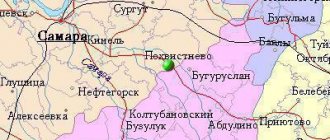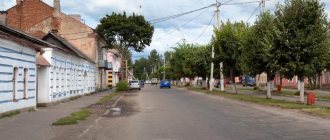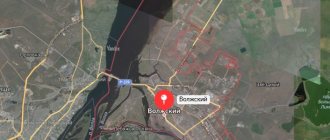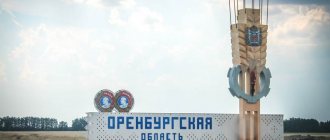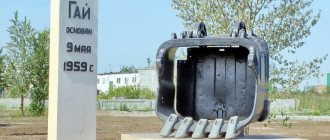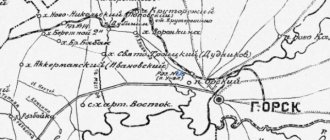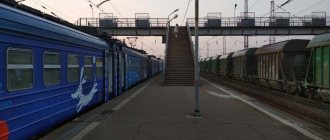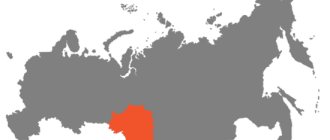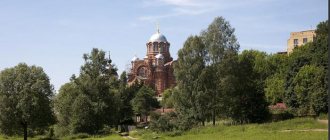This term has other meanings, see Abdulino (station).
| City Abdulino Flag |
| A country | Russia, Russia |
| Subject of the federation | Orenburg region Orenburg region |
| Urban district | Abdulinsky |
| Coordinates | 53°41′00″ n. w. 53°39′00″ E. long / 53.68333° north w. 53.65000° E. d. / 53.68333; 53.65000 (G) [www.openstreetmap.org/?mlat=53.68333&mlon=53.65000&zoom=13 (O)] (Z)Coordinates: 53°41′00″ N. w. 53°39′00″ E. long / 53.68333° north w. 53.65000° E. d. / 53.68333; 53.65000 (G) [www.openstreetmap.org/?mlat=53.68333&mlon=53.65000&zoom=13 (O)] (I) |
| Chapter | Naseikin V.V. |
| First mention | 1795 |
| City with | 1923 |
| Square | 47 km² |
| Center height | 190 |
| Population | ↘19,320[1] people (2016) |
| Density | 411.06 people/km² |
| Names of residents | Abdulinians, Abdulinets |
| Timezone | UTC+5 |
| Telephone code | +7 35355 |
| Postal codes | 461743 |
| Vehicle code | 56 |
| OKATO code | [classif.spb.ru/classificators/view/okt.php?st=A&kr=1&kod=53404 53 404] |
| Abdulino Moscow |
| Orenburg Abdulino |
Abdulino
- a city in Russia, in the Orenburg region. The city is the administrative center of the Abdulinsky municipal district and the urban settlement of Abdulino.
Personalities
- Rykov, Konstantin Konstantinovich, test pilot 1st class, Hero of the Soviet Union, participant in the Great Patriotic War, colonel.
- Kildyashov Alexander - graduated in 1971, chief surgeon of the space forces, colonel of the medical service, Honored Doctor of Russia, Doctor of Medical Sciences.
- Neznamov Vasily - graduate of 1961, director of the Institute of the Nuclear Center, Doctor of Physical and Mathematical Sciences, twice laureate of the State Prize of the USSR and the Russian Federation, Honored Scientist, Order Bearer.
- Kotov Alexander - graduated in 1951 from the Higher Naval School. Dzerzhinsky. Commander of the electrical engineering group of a nuclear submarine. Died while performing a combat mission. Order bearer.
- Myasnikov Vladimir Nikolaevich - school 21, graduate of 1955, Honorary radio operator of the USSR, Honored signalman of the Republic of Bashkortostan. Order bearer (USSR Badge of Honor, Honorary Veteran of Communications, USSR Labor Veteran).
Map
| Abdulino: maps |
Abdulino: photo from space (Google Maps) Abdulino: photo from space (Microsoft Virtual Earth)
| Abdulino. Nearest cities. Distances in km. on the map (in brackets along roads) + direction. Using the hyperlink in the distance , you can get the route (information courtesy of the AutoTransInfo website) | |||
| 1 | Matveevka | 22 (32) | SW |
| 2 | Priyutovo (Republic of Bashkortostan) | 30 (193) | NE |
| 3 | Bizhbulyak (Republic of Bashkortostan) | 40 (72) | IN |
| 4 | Ermekeyevo (Republic of Bashkortostan) | 44 (164) | WITH |
| 5 | Ponomarevka | 50 (58) | SE |
| 6 | Asekeevo | 56 (134) | Z |
| 7 | Belebey | 56 (180) | NE |
| 8 | Kirghiz-Miyaki (Republic of Bashkortostan) | 75 (269) | IN |
| 9 | Buguruslan | 81 (108) | Z |
| 10 | Serafimovsky (Republic of Bashkortostan) | 82 (112) | WITH |
| 11 | Bavly | 83 (81) | WITH |
| 12 | Northern | 86 (165) | NW |
| 13 | October | 89 (102) | WITH |
| 14 | Pleshanovo | 93 () | YU |
| 15 | Raevsky (Republic of Bashkortostan) | 94 (253) | NE |
| 16 | Subkhankulovo (Republic of Bashkortostan) | 98 (130) | WITH |
| 17 | Grachevka | 98 (263) | SW |
| 18 | Pokhvistnevo | 99 (127) | Z |
| 19 | Tuymazy | 101 (122) | WITH |
| 20 | Kandra (Republic of Bashkortostan) | 101 (149) | WITH |
| 21 | Urussu (Republic of Tatarstan) | 102 (118) | WITH |
| 22 | Davlekanovo | 108 (253) | NE |
| 23 | Kamyshla (Samara region) | 109 (185) | NW |
| 24 | Sterlibashevo (Republic of Bashkortostan) | 109 (249) | IN |
| 25 | Bugulma | 110 (119) | NW |
| 26 | Sharlyk | 110 (133) | SE |
| 27 | Buzdyak (Republic of Bashkortostan) | 113 (192) | NE |
| 28 | Fedorovka (Republic of Bashkortostan) | 117 (219) | SE |
a brief description of
The city is located in the Urals, on the river. Tiris (Surmet??) (tributary of the Ik River).
Railway node
Territory (sq. km): 1786
Information about the city of Abdulino on the Russian Wikipedia site
Historical sketch
Mentioned in a document of 1795 as the “newly established village of Abdulov”. Named in honor of elder Abdul Yakupov. Since 1811 Abdulino.
After the construction of the Samara-Zlatoust Railway in 1886-88, it became a railway junction. station, a significant center for grain processing and grain trading.
City since 1923.
Economy
A plant for the repair of track machines and the production of spare parts, a bakery plant, an experimental plant for the production of agricultural machines, etc.
In the Abdulinsky district, wheat, rye, barley, oats, buckwheat, peas, corn, potatoes, and beets are grown. They raise cattle, pigs, and horses.
Deposits of limestone, gypsum, ocher.
To the southeast of Abdulino, in the upper reaches of the Dema River, there is a group of oil and gas fields.
Main enterprises
TRACTOR AND AGRICULTURAL ENGINEERING
JSC "Abdulino Experimental Plant"
461760, Orenburg region, Abdulino, st.
Mira, 32 Offers:
Hay bale throwers, loaders, arched warehouses, plows, horse-drawn metal sleighs, wheels for carts
Culture, science, education
Apartment-museum F.P. Kazantsev - inventor of automatic railway. brakes
Universities of the city
Moscow State University of Technology and Management (Abdulinsky branch)
461740, Orenburg region, Abdulino, Kommunisticheskaya st., 85
Museums, galleries, exhibition halls
Abdulino Museum of History and Local Lore 461760, Orenburg region, Abdulino, st. Short, 1 Phone(s): 47-6383
Architecture, sights
Railway building station (1895).
| Population by year (thousands of inhabitants) | |||||||
| 1931 | 15.1 | 1992 | 23 | 2007 | 21.2 | 2016 | 19.3 |
| 1939 | 24.3 | 1996 | 23.6 | 2008 | 20.9 | 2017 | 19.2 |
| 1959 | 30.0 | 1998 | 23.9 | 2010 | 20.7 | 2018 | 19.0 |
| 1967 | 26 | 2000 | 24.1 | 2011 | 20.2 | 2019 | 18.8 |
| 1970 | 26.0 | 2001 | 24.0 | 2012 | 19.9 | 2020 | 18.6 |
| 1979 | 23.1 | 2003 | 21.5 | 2013 | 19.7 | 2021 | 18.4 |
| 1989 | 22.6 | 2005 | 21.5 | 2014 | 19.5 | ||
| 1991 | 22.9 | 2006 | 21.4 | 2015 | 19.4 | ||
Notes
- ↑ 12
www.gks.ru/free_doc/doc_2016/bul_dr/mun_obr2016.rar Population of the Russian Federation by municipalities as of January 1, 2021 - ↑ 123456789101112
www.MojGorod.ru/orenburg_obl/abdulino/index.html People's encyclopedia “My City”. Abdulino - [demoscope.ru/weekly/ssp/rus59_reg2.php All-Union Population Census of 1959. The size of the urban population of the RSFSR, its territorial units, urban settlements and urban areas by gender] (Russian). Demoscope Weekly. Retrieved September 25, 2013. [www.webcitation.org/6GDOghWC9 Archived from the original on April 28, 2013].
- [demoscope.ru/weekly/ssp/rus70_reg2.php All-Union Population Census of 1970 The size of the urban population of the RSFSR, its territorial units, urban settlements and urban areas by gender.] (Russian). Demoscope Weekly. Retrieved September 25, 2013. [www.webcitation.org/6GDOiMstp Archived from the original on April 28, 2013].
- [demoscope.ru/weekly/ssp/rus79_reg2.php All-Union Population Census of 1979 The size of the urban population of the RSFSR, its territorial units, urban settlements and urban areas by gender.] (Russian). Demoscope Weekly. Retrieved September 25, 2013. [www.webcitation.org/6GDOjhZ5L Archived from the original on April 28, 2013].
- [demoscope.ru/weekly/ssp/rus89_reg2.php All-Union Population Census of 1989. Urban population]. [www.webcitation.org/617x0o0Pa Archived from the original on August 22, 2011].
- [www.perepis2002.ru/ct/doc/1_TOM_01_04.xls All-Russian Population Census 2002. Volume. 1, table 4. Population of Russia, federal districts, constituent entities of the Russian Federation, districts, urban settlements, rural settlements - regional centers and rural settlements with a population of 3 thousand or more]. [www.webcitation.org/65AdCU0q3 Archived from the original on February 3, 2012].
- ↑ 12
[istmat.info/files/uploads/36125/goroda_i_rayony_orenburgskoy_obl._2004.pdf Cities and districts of the Orenburg region. Orenburg. Printing house of Orenburgstat. 2004. - 283 p.]. Retrieved May 3, 2015. [www.webcitation.org/6YFCcrYVc Archived from the original on May 3, 2015]. - [www.gks.ru/bgd/regl/b08_14t/IssWWW.exe/Stg/p/10.htm Administrative-territorial division of the Orenburg region as of January 1, 2008]. Retrieved May 11, 2021. [www.webcitation.org/6hQRIDAFG Archived from the original on May 11, 2016].
- [www.gks.ru/bgd/regl/B09_109/IssWWW.exe/Stg/d01/tabl-21-09.xls Number of permanent population of the Russian Federation by cities, urban-type settlements and districts as of January 1, 2009]. Retrieved January 2, 2014. [www.webcitation.org/6MJmu0z1u Archived from the original on January 2, 2014].
- [orenstat.gks.ru/wps/wcm/connect/rosstat_ts/orenstat/resources/b1b78e8041fa1606a052ec2d59c15b71/Volume+1+Number+and+location.zip All-Russian Population Census 2010. Number and distribution of the population of the Orenburg region]. Retrieved June 5, 2014. [www.webcitation.org6Q6U2f9Hn/ Archived from the original on June 5, 2014].
- [www.gks.ru/free_doc/doc_2012/bul_dr/mun_obr2012.rar Population of the Russian Federation by municipalities. Table 35. Estimated resident population as of January 1, 2012]. Retrieved May 31, 2014. [www.webcitation.org/6PyOWbdMc Archived from the original on May 31, 2014].
- [www.gks.ru/free_doc/doc_2013/bul_dr/mun_obr2013.rar Population of the Russian Federation by municipalities as of January 1, 2013. - M.: Federal State Statistics Service Rosstat, 2013. - 528 p. (Table 33. Population of urban districts, municipal districts, urban and rural settlements, urban settlements, rural settlements)]. Retrieved November 16, 2013. [www.webcitation.org/6LAdCWSxH Archived from the original on November 16, 2013].
- [www.gks.ru/free_doc/doc_2014/bul_dr/mun_obr2014.rar Table 33. Population of the Russian Federation by municipalities as of January 1, 2014]. Retrieved August 2, 2014. [www.webcitation.org/6RWqP50QK Archived from the original on August 2, 2014].
- [www.gks.ru/free_doc/doc_2015/bul_dr/mun_obr2015.rar Population of the Russian Federation by municipalities as of January 1, 2015]. Retrieved August 6, 2015. [www.webcitation.org/6aaNzOlFO Archived from the original on August 6, 2015].
- taking into account the cities of Crimea
- [www.gks.ru/free_doc/doc_2016/bul_dr/mun_obr2016.rar Population of the Russian Federation by municipalities as of January 1, 2021. Table “31. Population of cities and towns by federal districts and constituent entities of the Russian Federation as of January 1, 2021.” RAR archive (1.0 MB)]
- Great Soviet Encyclopedia. Ch. ed. A. M. Prokhorov, 3rd ed. T. 1. A - Engob. 1969. 608 pp., ill.; 47 l. ill. and maps, 1 dept. l. table
- [www.poezda.net/articles/abdulino.shtml Abdulino station]
Historical excursion
The first mention of this settlement was found in 1795. This is considered the date of birth of Abdulino. The village received its name in honor of its founder, the successful merchant Abdula Yakupov. For 100 years, this settlement was just a small village.
Like other corners of the Russian Federation, the Orenburg region captivates with its beauty. Abdulino was transformed from a rural settlement. After the construction of the railroad in 1811, business life in this city became noticeably livelier, which led to an increase in the local population. The legendary Orenburg highway, passing through the village (now the Kazan-Orenburg federal highway), also contributed greatly to prosperity. Since 1923, Abdulino turned into a city, then became a regional center.
Excerpt characterizing Abdulino
Pierre, feeling out of place and idle, afraid to interfere with someone again, galloped after the adjutant. - This is here, what? Can I come with you? - he asked. “Now, now,” answered the adjutant and, galloping up to the fat colonel standing in the meadow, he handed him something and then turned to Pierre. - Why did you come here, Count? - he told him with a smile. -Are you all curious? “Yes, yes,” said Pierre. But the adjutant, turning his horse, rode on. “Thank God here,” said the adjutant, “but on Bagration’s left flank there is a terrible heat going on.” - Really? asked Pierre. - Where is this? - Yes, come with me to the mound, we can see from us. “But our battery is still bearable,” said the adjutant. - Well, are you going? “Yes, I’m with you,” said Pierre, looking around him and looking for his guard with his eyes. Here, only for the first time, Pierre saw the wounded, wandering on foot and carried on stretchers. In the same meadow with fragrant rows of hay through which he drove yesterday, across the rows, his head awkwardly turned, one soldier lay motionless with a fallen shako. - Why wasn’t this raised? - Pierre began; but, seeing the stern face of the adjutant, looking back in the same direction, he fell silent. Pierre did not find his guard and, together with his adjutant, drove down the ravine to the Raevsky mound. Pierre's horse lagged behind the adjutant and shook him evenly. “Apparently you’re not used to riding a horse, Count?” – asked the adjutant. “No, nothing, but she’s jumping around a lot,” Pierre said in bewilderment. “Eh!.. yes, she’s wounded,” said the adjutant, “right front, above the knee.” Must be a bullet. Congratulations, Count,” he said, “le bapteme de feu [baptism by fire]. Having driven through the smoke through the sixth corps, behind the artillery, which, pushed forward, was firing, deafening with its shots, they arrived at a small forest. The forest was cool, quiet and smelled of autumn. Pierre and the adjutant dismounted from their horses and entered the mountain on foot. - Is the general here? – asked the adjutant, approaching the mound. “We were there now, let’s go here,” they answered him, pointing to the right. The adjutant looked back at Pierre, as if not knowing what to do with him now. “Don’t worry,” said Pierre. – I’ll go to the mound, okay? - Yes, go, you can see everything from there and it’s not so dangerous. And I'll pick you up. Pierre went to the battery, and the adjutant went further. They did not see each other again, and much later Pierre learned that this adjutant’s arm was torn off that day. The mound that Pierre entered was the famous one (later known among the Russians under the name of the kurgan battery, or Raevsky’s battery, and among the French under the name la grande redoute, la fatale redoute, la redoute du center [the great redoubt, the fatal redoubt, the central redoubt ] a place around which tens of thousands of people were positioned and which the French considered the most important point of the position. This redoubt consisted of a mound on which ditches were dug on three sides. In a place dug in by ditches there were ten firing cannons, protruding into the opening of the ramparts. In line with the mound. there were cannons on both sides, also firing incessantly. A little behind the cannons stood infantry troops. Entering this mound, Pierre did not think that this place, dug in with small ditches, where several cannons stood and fired, was the most important place in the battle. Pierre ", on the contrary, it seemed that this place (precisely because he was on it) was one of the most insignificant places of the battle. Entering the mound, Pierre sat down at the end of the ditch surrounding the battery, and with an unconsciously joyful smile looked at what was happening Around him. From time to time, Pierre still stood up with the same smile and, trying not to disturb the soldiers who were loading and rolling guns, constantly running past him with bags and charges, walked around the battery. The guns from this battery fired continuously one after another, deafening with their sounds and covering the entire area with gunpowder smoke. In contrast to the creepiness that was felt between the infantry soldiers of the cover, here, on the battery, where a small number of people busy with work are white limited, separated from others by a ditch - here one felt the same and common to everyone, as if a family revival. The appearance of the non-military figure of Pierre in a white hat initially struck these people unpleasantly. The soldiers, passing by him, glanced sideways at his figure in surprise and even fear. The senior artillery officer, a tall, long-legged, pockmarked man, as if to watch the action of the last gun, approached Pierre and looked at him curiously. A young, round-faced officer, still a complete child, apparently just released from the corps, very diligently disposing of the two guns entrusted to him, addressed Pierre sternly. “Mister, let me ask you to leave the road,” he told him, “it’s not allowed here.” The soldiers shook their heads disapprovingly, looking at Pierre. But when everyone was convinced that this man in a white hat not only did nothing wrong, but either sat quietly on the slope of the rampart, or with a timid smile, courteously avoiding the soldiers, walked along the battery under gunfire as calmly as along the boulevard, then Little by little, the feeling of hostile bewilderment towards him began to turn into affectionate and playful sympathy, similar to that which soldiers have for their animals: dogs, roosters, goats and in general animals living with military commands. These soldiers immediately mentally accepted Pierre into their family, appropriated them and gave him a nickname. “Our master” they nicknamed him and laughed affectionately about him among themselves.
